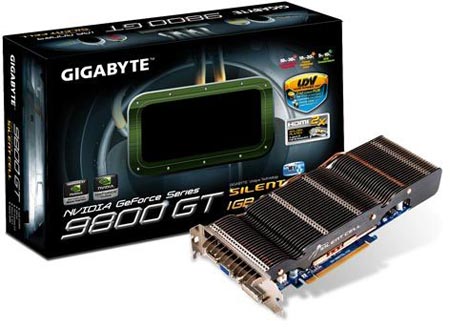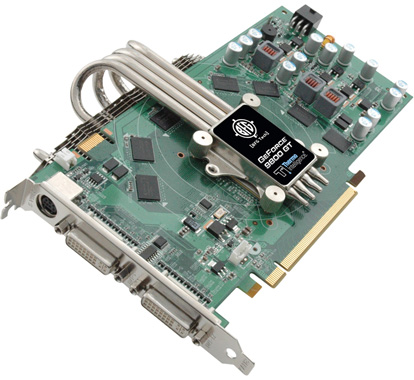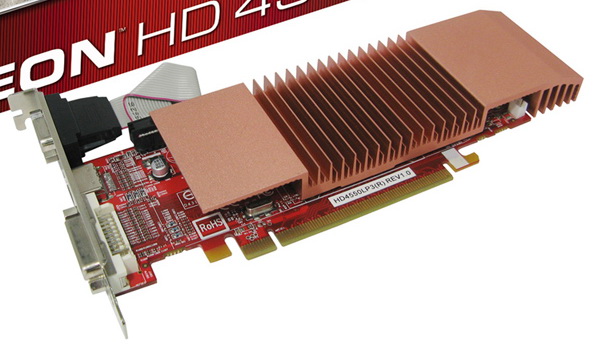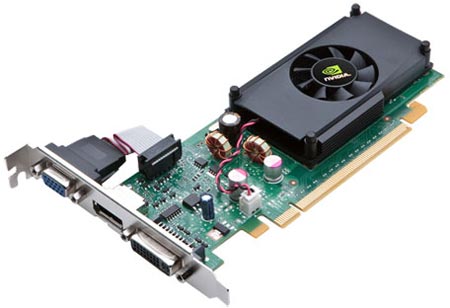Quick and quiet: Video cards with passive cooling. Application outside the game
Manufacturers of modern video cards are gradually shifting the focus towards non-graphical computing on the GPU. Apparently, they are tired of limiting the scope of application for their powerful super-complex devices to only a narrow sphere of games. That is why NVIDIA CUDA and ATI Stream appeared. More and more applications using these technologies and resulting in a large performance increase are coming out.
If you are not fond of modern games, before the appearance of the above-mentioned technologies, a powerful video card was practically useless, and it was quite possible to do with the graphics built into the chipset. But the situation is slowly changing, as discussed in more detail below.
For me, another obstacle in the use of modern video cards is the unacceptable level of noise they emit. If you need a complete absence of noise, then any cooling system that has a fan will be inappropriate. Even if most of the time it will not make loud sounds, you will still hear it under heavy load, otherwise why is there a fan at all?
')
Therefore, I tried to find options with fully passive cooling. Unfortunately, the top models are not included in the list - it seems that it is impossible to cool them with a regular radiator. But still managed to find some good options. So, in order.
Gigabyte GeForce 9800 GT .

A proprietary cooling system, Silent-Cell, developed for the GT 9600 is used. As usual, heat pipes and lots and lots of copper are used. But the processor is far from cold, so I think this is a worthy result. The F-Center has a detailed review .
Also on the 9800 GT chip passive card released BFG .

Here, the radiator is much smaller than that of Gigabyte and is located unusually - on the back side of the printed circuit board, which allows you to install other peripherals in adjacent slots. And since they managed to get away with such a small radiator, it is to be hoped that soon more powerful passive video cards will be released.
ATI processors also have some pretty powerful options.
This is, firstly, the Gigabyte Radeon HD 4770 with the same massive heatsink.

Then GeCube Radeon HD 4550 .

The processor is weaker here, so the cooling is quite simple.
And, as it turned out, more than six months ago, the same Gigabyte released the passive Radeon HD 4850 .

This is a very powerful card, the most powerful card I've ever encountered with passive cooling. Perhaps now it is one of the best options for a silent system.
You shouldn’t forget, however, that in the requirements for many passive video cards they write the obligatory presence of an internal case fan. But here it is much easier to pick up a silent model - for example, a recent excellent review .
And finally, about the near future. GPUs made using the 40-nanometer process technology will probably not be so hot. Just look at the GeForce G210 photo:

I think that making the passive version will be much easier here.
Now, actually, about technologies - for what we have a city or a vegetable garden with an expensive powerful video card.
I don’t know what the reason is, but NVIDIA CUDA is progressing with a much bigger pomp than ATI Stream. I haven’t seen any good articles about applications that can use ATI technology. Perhaps the reason is its greater complexity for the developer, or less efficiency. I have not had time to thoroughly understand. Therefore, the following articles are mainly about the results obtained for CUDA. I do not pretend to have a complete review, just cite a few scattered links.
Here you can see Cyberlink Power Director test results when encoding video of different resolutions with acceleration support enabled on the GPU and without it. Full HD encoding was able to speed up by 2 times, lower resolutions are not accelerated so well. And here tests another product Cyberlink - MediaShow.
At THG, there is also a small report on testing several programs for the mainstream market — these are also mostly encoders and converters.
Further, an interesting utility for improving the quality of the video - vReveal . You can skip the video through many filters and get a noticeably higher quality image at the output. In this case, using the hardware acceleration, the program runs much faster. There is a video showing the effect of switching on and off acceleration. True, there is a limit on the size of the frame - HD does not yet support.
And finally, a little pretentious note without details about the fivefold acceleration of video encoding in Nero Move It using NVIDIA CUDA.
Quite a lot of interesting details about CUDA can be found in an interview with Andy Keane from NVIDIA. For example, about C ++ support.
In general, the technologies from both GPU manufacturers are quite interesting and definitely deserve attention. It is clear that the producers themselves are trying hard to promote them to the masses - this is a very large market.
Active movement in this area could not help but notice Intel, seeing here a direct threat to the market of powerful CPUs. And, apparently, the company is preparing a decent response. At least, I got this impression after a note on the Larrabee platform , based on the good old x86 architecture. The article is rather vague, and the details are unclear. Perhaps, Intel also does not have a final plan yet, or simply does not want to disclose all the details ahead of time.
However, unlike Larrabee, the effect of using acceleration on the GPU can be checked right now, simply by purchasing a good video card. At least for those involved in high-resolution video processing, this will help speed up the work. Now, however, support is limited to a very small number of programs, and the results are not very impressive so far. However, after some time, the technology will settle down, and then rather the lack of hardware acceleration will be an exception.
If you are not fond of modern games, before the appearance of the above-mentioned technologies, a powerful video card was practically useless, and it was quite possible to do with the graphics built into the chipset. But the situation is slowly changing, as discussed in more detail below.
For me, another obstacle in the use of modern video cards is the unacceptable level of noise they emit. If you need a complete absence of noise, then any cooling system that has a fan will be inappropriate. Even if most of the time it will not make loud sounds, you will still hear it under heavy load, otherwise why is there a fan at all?
')
Therefore, I tried to find options with fully passive cooling. Unfortunately, the top models are not included in the list - it seems that it is impossible to cool them with a regular radiator. But still managed to find some good options. So, in order.
Gigabyte GeForce 9800 GT .

A proprietary cooling system, Silent-Cell, developed for the GT 9600 is used. As usual, heat pipes and lots and lots of copper are used. But the processor is far from cold, so I think this is a worthy result. The F-Center has a detailed review .
Also on the 9800 GT chip passive card released BFG .

Here, the radiator is much smaller than that of Gigabyte and is located unusually - on the back side of the printed circuit board, which allows you to install other peripherals in adjacent slots. And since they managed to get away with such a small radiator, it is to be hoped that soon more powerful passive video cards will be released.
ATI processors also have some pretty powerful options.
This is, firstly, the Gigabyte Radeon HD 4770 with the same massive heatsink.

Then GeCube Radeon HD 4550 .

The processor is weaker here, so the cooling is quite simple.
And, as it turned out, more than six months ago, the same Gigabyte released the passive Radeon HD 4850 .

This is a very powerful card, the most powerful card I've ever encountered with passive cooling. Perhaps now it is one of the best options for a silent system.
You shouldn’t forget, however, that in the requirements for many passive video cards they write the obligatory presence of an internal case fan. But here it is much easier to pick up a silent model - for example, a recent excellent review .
And finally, about the near future. GPUs made using the 40-nanometer process technology will probably not be so hot. Just look at the GeForce G210 photo:

I think that making the passive version will be much easier here.
Now, actually, about technologies - for what we have a city or a vegetable garden with an expensive powerful video card.
I don’t know what the reason is, but NVIDIA CUDA is progressing with a much bigger pomp than ATI Stream. I haven’t seen any good articles about applications that can use ATI technology. Perhaps the reason is its greater complexity for the developer, or less efficiency. I have not had time to thoroughly understand. Therefore, the following articles are mainly about the results obtained for CUDA. I do not pretend to have a complete review, just cite a few scattered links.
Here you can see Cyberlink Power Director test results when encoding video of different resolutions with acceleration support enabled on the GPU and without it. Full HD encoding was able to speed up by 2 times, lower resolutions are not accelerated so well. And here tests another product Cyberlink - MediaShow.
At THG, there is also a small report on testing several programs for the mainstream market — these are also mostly encoders and converters.
Further, an interesting utility for improving the quality of the video - vReveal . You can skip the video through many filters and get a noticeably higher quality image at the output. In this case, using the hardware acceleration, the program runs much faster. There is a video showing the effect of switching on and off acceleration. True, there is a limit on the size of the frame - HD does not yet support.
And finally, a little pretentious note without details about the fivefold acceleration of video encoding in Nero Move It using NVIDIA CUDA.
Quite a lot of interesting details about CUDA can be found in an interview with Andy Keane from NVIDIA. For example, about C ++ support.
In general, the technologies from both GPU manufacturers are quite interesting and definitely deserve attention. It is clear that the producers themselves are trying hard to promote them to the masses - this is a very large market.
Active movement in this area could not help but notice Intel, seeing here a direct threat to the market of powerful CPUs. And, apparently, the company is preparing a decent response. At least, I got this impression after a note on the Larrabee platform , based on the good old x86 architecture. The article is rather vague, and the details are unclear. Perhaps, Intel also does not have a final plan yet, or simply does not want to disclose all the details ahead of time.
However, unlike Larrabee, the effect of using acceleration on the GPU can be checked right now, simply by purchasing a good video card. At least for those involved in high-resolution video processing, this will help speed up the work. Now, however, support is limited to a very small number of programs, and the results are not very impressive so far. However, after some time, the technology will settle down, and then rather the lack of hardware acceleration will be an exception.
Source: https://habr.com/ru/post/69325/
All Articles